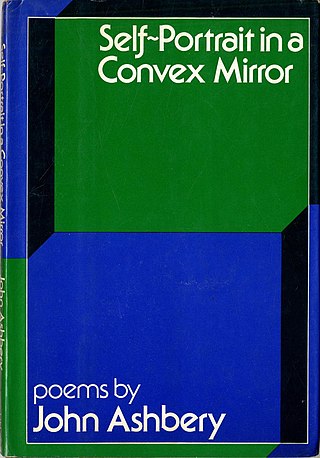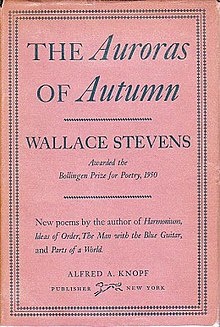
Robert Lee Frost was an American poet. His work was initially published in England before it was published in the United States. Known for his realistic depictions of rural life and his command of American colloquial speech, Frost frequently wrote about settings from rural life in New England in the early 20th century, using them to examine complex social and philosophical themes.

William Carlos Williams was an American poet, writer, and physician closely associated with modernism and imagism.

Wallace Stevens was an American modernist poet. He was born in Reading, Pennsylvania, educated at Harvard and then New York Law School, and spent most of his life working as an executive for an insurance company in Hartford, Connecticut. He won the Pulitzer Prize for Poetry in 1955 for his Collected Poems.

John Lawrence Ashbery was an American poet and art critic.

Sir Geoffrey William Hill, FRSL was an English poet, professor emeritus of English literature and religion, and former co-director of the Editorial Institute, at Boston University. Hill has been considered to be among the most distinguished poets of his generation and was called the "greatest living poet in the English language." From 2010 to 2015 he held the position of Professor of Poetry in the University of Oxford. Following his receiving the Truman Capote Award for Literary Criticism in 2009 for his Collected Critical Writings, and the publication of Broken Hierarchies , Hill is recognised as one of the principal contributors to poetry and criticism in the 20th and 21st centuries.

Mark Strand was a Canadian-born American poet, essayist and translator. He was appointed Poet Laureate Consultant in Poetry to the Library of Congress in 1990 and received the Wallace Stevens Award in 2004. Strand was a professor of English and Comparative Literature at Columbia University from 2005 until his death in 2014.

Harmonium is a book of poetry by American poet Wallace Stevens. His first book at the age of forty-four, it was published in 1923 by Knopf in an edition of 1500 copies. This collection comprises 85 poems, ranging in length from just a few lines to several hundred. Harmonium was reissued in 1931 with three poems omitted and fourteen new poems added.

Archibald Randolph Ammons was an American poet and professor of English at Cornell University. Ammons published nearly thirty collections of poems in his lifetime. Revered for his impact on American romantic poetry, Ammons received several major awards for his work, including two National Book Awards for Poetry, one in 1973 for Collected Poems and another in 1993 for Garbage.
"The Emperor of Ice-Cream" is a poem from Wallace Stevens's first collection of poetry, Harmonium (1923). Stevens' biographer, Paul Mariani, identifies the poem as one of Stevens' personal favorites from the Harmonium collection. The poem "wears a deliberately commonplace costume", he wrote in a letter, "and yet seems to me to contain something of the essential gaudiness of poetry; that is the reason why I like it".
"Le Monocle de Mon Oncle" is a poem from Wallace Stevens's first book of poetry, Harmonium. It was first published in 1918.
Nationality words link to articles with information on the nation's poetry or literature.
"The Comedian as the Letter C" is a poem from Wallace Stevens's first book of poetry, Harmonium (1923). It was one of the few poems first published in that collection and the last written for it. John Gould Fletcher frames the poem as expressing Stevens's view "that the artist can do nothing else but select out of life the elements to form a 'fictive' or fictitious reality."
"The Idea of Order at Key West" is a poem written in 1934 by modernist poet Wallace Stevens. It is one of many poems included in his book, Ideas of Order. It was also included in The Collected Poems of Wallace Stevens for which he won the Pulitzer Prize for Poetry.
"Theory" is a poem from Wallace Stevens's first book of poetry, Harmonium. It was first published in 1917, and is in the public domain.
"The Death of a Soldier" is a poem from Wallace Stevens's first book of poetry, Harmonium. The poem uses free verse to describe the death of a soldier.

Harold Bloom was an American literary critic and the Sterling Professor of humanities at Yale University. In 2017, Bloom was called "probably the most famous literary critic in the English-speaking world". After publishing his first book in 1959, Bloom wrote more than 50 books, including over 40 books of literary criticism, several books discussing religion, and one novel. He edited hundreds of anthologies concerning numerous literary and philosophical figures for the Chelsea House publishing firm. Bloom's books have been translated into more than 40 languages. He was elected to the American Philosophical Society in 1995.
Robert Pack was an American poet and critic, and Distinguished Senior Professor in the Davidson Honors College at the University of Montana - Missoula. For thirty-four years he taught at Middlebury College and from 1973 to 1995 served as director of the Bread Loaf Writers' Conference. He is the author of twenty-two books of poetry and criticism. Pack has been called, by Harold Bloom, an heir to Robert Frost and Edwin Arlington Robinson, and has himself published a volume of admiring essays on Frost's poetry. He has co-edited several books with Jay Parini, including Writers on Writing: A Breadloaf Anthology.

Self-Portrait in a Convex Mirror is a 1975 poetry collection by the American writer John Ashbery. The title, shared with its final poem, comes from the painting of the same name by the Late Renaissance artist Parmigianino. The book won the Pulitzer Prize, the National Book Award, and the National Book Critics Circle Award, the only book to have received all three awards.

Paul Kane is an American poet, critic and scholar. Awards for his work include Fellowships from the National Endowment for the Humanities, the Guggenheim Foundation, the Bogliasco Foundation, a Fulbright Award, and an honorary doctorate from La Trobe University in Australia. He is also considered an Australian poet. Kane teaches at Vassar College and lives in Warwick, New York.











